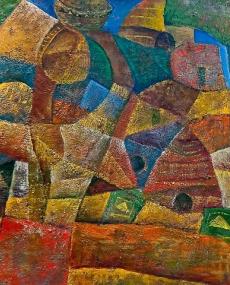
The quiet and yet temperamental Martin Qgibinsizi Tose was born in Germiston, Johannesburg during the first decade of Apartheid. His birth coincided with the ruling National Party’s second successive Whites only general elections victory. The year was also characterised by the start of the Treason Trial, the compulsory carrying of pass books for Black people and the breakaway of the Africanists section from the African National Congress after they were barred from attending public meetings. Tose was born when Dr Hendrik Verwoerd was chosen to succeed the country’s late Prime Minister, Johannes Strijdom after he died in 1958.
He established himself as a sculptor, graphic artist and a painter during his late teens. Tose attended part-time art classes at the Open School in Braamfontein, Johannesburg under the guidance of Nathaniel Mokgosi between 1975 and 1977. The Open School was opened in 1974 to equip high school learners with foundational skills in fine art and music. He spent the next three years until 1980 at Katlehong Art Centre, studying under Thato Mamabolo whom trained at Ndaleni Teacher’s Training College in KwaZulu Natal.
Tose’s subject matter ranges from landscapes, wild life and figure studies in oil, to sculpture in wood, bronze and mixed media. Tose’s handling of the various media tends to veer his work towards abstraction. His titles, such as ‘Orange Moon’, ‘Entering Jerusalem’ and ‘Moving Day’ and his use of colour reveal the artist’s reflections on issues of spirituality and mythology.
‘Moving Day’ is a 32x52 cm mixed media piece on paper that was executed in 1990. The work shows a dynamic group of figures; male, female, children and their dogs moving from the left of the picture surface. One female figure is seen carrying a chair on her head and a baby on her back. Another is seen moving a single bed on her head while a young male figure is pushing a cart that carries what looks like a chest of drawers. This linear composition fills the entire frame with tints of ocher and blues that disrupt the white surface. Tose seems to be expressing the temporality of life in the townships when families are often evicted from their four-roomed houses or carry their household goods from one backroom dwelling to another. The artist’s tongue-in-cheek depiction of the realities of the poor raises questions about the sensibility of human interactions. The work shows the abnormality of the situation in its portrayal of families and pets that travel with their furniture on foot. ‘Moving Day’ may be Tose’s testament about how the indignities of the downtrodden are often normalized: a sad state, which seems to be currently accelerated.
Since 1978 he participated in various group exhibitions until his untimely death at the age of 46. Although his life was cut short by kidney complications, Tose’s work forms part of the collections of major banks, universities and national galleries in the country. He died in 2004 in the Ekurhuleni township of Katlehong, southeast of Johannesburg.